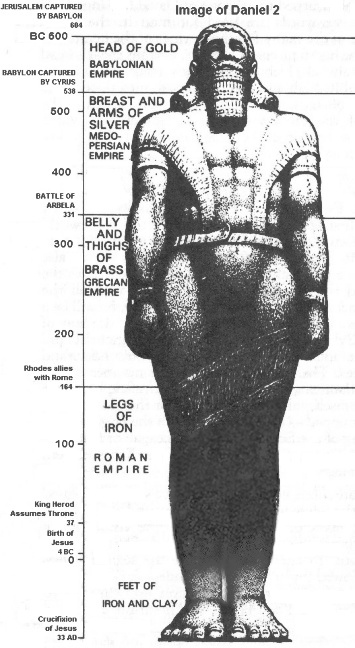Bible Truth Versus SDA Truth: Image of Daniel 2
In Daniel 2 an image is presented having a head of gold, chest and arms of silver, belly and thighs of brass, legs of iron, and feet of iron mixed with clay. Seventh-day Adventists interpret this image as follows:
1. Feet of Clay = 10 Tribes - Uriah Smith explains the identify of the feet: "We are therefore held to the conclusion that the ten toes of the image denote the ten parts into which the Roman Empire was divided. This division was accomplished between A.D. 351 and 476. ... The ten nations which were most instrumental in breaking up the Roman Empire, and which at some time in their history held respectively portions of Roman territory as separate and independent kingdoms, may be enumerated (without respect to the time of their establishment) as follows: Huns, Ostrogoths, Visigoths, Franks, Vandals, Suevi, Burgundians, Heruli, Anglo-Saxons, and Lombards."1 2. Stone strikes the feet at the Second Coming - Daniel describes a stone that strikes the image in the feet and destroys it. Seventh-day Adventists interpret this event as the Second Coming of Christ at the end of the age. 3. Rome is the last universal empire - Uriah Smith writes: With Rome fell the last of the world's universal empires. Heretofore it was possible for one nation, rising superior to its neighbors in prowess, bravery, and the science of war, to consolidate them into one vast empire. But when Rome fell, such possibilities forever passed away.2 |
1. Are the "feet of clay mixed with iron" ten tribes that conquer Rome? There were over 40 tribes that were involved in the downfall of the western Roman Empire. Even in Uriah Smith's day, there was controversy over who the "ten" actually were, because it was known that more than ten tribes were involved.3 Even more significant is the fact that the 40+ barbarian tribes never conquered the Eastern Roman Empire. The Eastern Roman Empire survived for nearly a thousand years after Rome fell. The Eastern Roman Empire was considered the continuation of the Roman Empire: "The Byzantine Empire or Eastern Roman Empire, known to its inhabitants as the Roman Empire, the Empire of the Romans, was the continuation of the Roman Empire during the Middle Ages, centered on its capital of Constantinople, and ruled by Emperors in direct succession to the ancient Roman Emperors." (Wikipedia) Notice in the picture on the right that in 476 AD, the Eastern Roman Empire (colored in red) covered a vast domain. The Eastern Roman Empire actually expanded over the next century, conquering much of the old Western Roman Empire including Rome itself (see picture on the lower right). Territory was gradually lost over the subsequent centuries, but the eastern empire was still considered the most powerful state in the Mediterranean in 1045 AD (Wikipedia). Constantinople, the capital of the eastern empire, finally fell to the Ottomans in 1453 AD, nearly 1,000 years after the fall of the Western Roman Empire. So, here is the first problem with SDA "truth." There were over forty tribes involved in the destruction of the Western Roman Empire, not ten. This means a toes does not equal a tribe. Furthermore, the forty tribes never conquered the Eastern Roman Empire. Therefore, there was no "iron mixed with clay" in the Eastern Roman Empire. In order for the SDA teaching to match the visual picture of the Daniel 2 image, the image would need to have one leg with forty toes on its clay/iron foot, (to represent the 40+ tribes that conquered the western half of the empire). The second leg, representing the eastern part of the empire, would need to have a foot of solid iron with no toes! Another problem with SDA "truth" is their claim that the "feet of clay mixed with iron" is a separate group of kingdoms that arise after the fall of Rome. This is a direct contradiction of what the Bible says: And the fourth kingdom shall be strong as iron... And whereas thou sawest the feet and toes, part of potters' clay, and part of iron, the kingdom shall be divided; but there shall be in it of the strength of the iron, forasmuch as thou sawest the iron mixed with miry clay. And [as] the toes of the feet [were] part of iron, and part of clay, [so] the kingdom shall be partly strong, and partly broken. (Dan. 2:40-42) Notice that there is only ONE kingdom (singular) described in this passage. There are not ten kingdoms! The Bible describes a single kingdom that becomes divided (not conquered!) after an element of "clay" is mixed into the kingdom. In the next section we will identify who the "clay" represents. Adventists use their interpretation of the ten horns of Daniel 7 to buttress their claim that the feet are ten European tribes, but that interpretation is equally problematic (click here to find out why). Finally, it is important to understand who this prophecy was intended for. The whole intent and purpose of the book of Daniel is to predict the history of God's people, the Jews, up until the end of their covenant relationship with God. It is a Jewish book, written by a Jew, written for Jews living under the Old Covenant. The ten tribes have little or nothing to do with Israel. The ten tribes never advanced into eastern Europe the Middle East, or Africa until many centuries after Rome's fall. The ten tribes certainly had no relevance to the Jews living under the Old Covenant. Therefore, the SDA interpretation of the feet has several shortcomings:
2. When does the stone strike the feet? Seventh-day Adventists teach that the stone striking the feet occurs at the Second Coming of Christ. Is this true? Notice what Daniel said: And in the days of these kings shall the God of heaven set up a kingdom, which shall never be destroyed: and the kingdom shall not be left to other people, [but] it shall break in pieces and consume all these kingdoms, and it shall stand for ever. (Dan. 2:44) Virtually all Christian scholars agree this stone represents Christ. The question is, when does Christ strike the image? As noted above, the feet of iron and clay is the fourth kingdom. Since the fourth kingdom is Rome, then the stone must strike the image during the days of the Roman Empire. Did Christ come during the time of the Roman Empire? He most certainly did. In fact, He made it abundantly clear that He came to establish a kingdom, and that evidence will be more fully explained below in the "Bible Truth" section.
The Ottoman Empire, the nation that conquered the (eastern) Roman Empire in 1453, rivalled the size and power of Rome. Founded in 1299 AD, this empire conquered a vast region spanning three continents. At the height of its expansion, the Ottoman Empire controlled ten percent more territory than the Rome Empire at its peak. Not only did the Ottoman Empire conquer the Middle East, but also Arabia, Mesopotamia, Southern Russia, Southeastern Europe, and Northern Africa. The picture on the right shows the immense reach of its dominion over the primary civilized areas of the earth. For centuries its fleets dominated the Mediterranean Sea. The Ottoman Empire was also an economic super-power, controlling the channels of trade between Europe, Asia, and Africa. The empire endured over six centuries, finally coming to an end in 1923. Not only did this empire rival Rome, but it greatly surpassed the size and power of prior empires identified in the book of Daniel, including Greece, Medo-Persia, and Babylon. Thus, the Ottoman Empire was a vast superpower that dominated Palestine and much of the civilized world for centuries. The mere existence of such an empire refutes the idea that the image of Daniel 2 delineates the rise and fall of all world empires until the Second Coming of Christ. It clearly does not delineate all empires. It only reveals the empires that existed during the Old Covenant.
The existence of this massive empire and that of the Ottoman Empire is proof that Daniel's image was never intended to cover all of human history, but only the history pertinent to the Jews living under the Old Covenant. | ||||||||
What is the "Division" of the Fourth Empire?Daniel 2:41 teaches that the fourth empire will become divided. Before the division, the empire is pictured as solid iron. After the division, it continues to have the strength of iron but is also mixed with a new element of fragile clay. Did such a division occur in history? The word "divided" is only used one other time by Daniel. It is used to describe the division of the Babylonian empire into two spheres, one controlled by the Medes and the other by the Persians (Dan. 5:28). But unlike the complete transition from Babylon (gold) to Persia/Medes (silver), in the Roman division the iron remains. This indicates a continuity of Roman rule, but the introduction of an additional element (clay).
Under the first emperor, Augustus, these client states became an important part of the Roman Empire. A great example of a client state is Judea. Judea was ruled by a local king named Herod, who was an Edomite raised as a Jew. He ruled not only Judea, but also Galilee and the surrounding areas. Herod rebuilt the temple of Jerusalem into a massive, magnificent structure. It was one of the largest building projects in the entire Roman Empire. After he died, the client state was divided into three areas ruled by his three sons. Daniel 2:43 tells us the iron and clay "will mix with one another in marriage, but they will not hold together." Intermarriage amongst the leaders was common but without lasting unity. For example, Herod the Great had ten wives, including a niece and a cousin. Historians tell us that every marriage was for political purposes. One wife was from a Jewish princess from the prior Jewish dynasty. One was the daughter of a Jewish priest. Thus, they mixed in marriage but there was no lasting union.
What is the "stone" and when does it strike?5God showed Daniel an outline of history in which a towering statue is struck down and crushed by a stone; "and the stone that struck the statue became a great mountain and filled the whole earth" (Dan. 2:35). The meaning of this vision is the restoration of Eden under the King, as Daniel explained: "In the days of those kings [i.e., during the period of the Roman Empire] the God of heaven will set up a Kingdom which will never be destroyed; and that Kingdom will not be left for another people; it will crush and put an end to all these kingdoms, but it will itself endure forever" (Dan. 2:44). Christ, the Second Adam, will perform the task assigned to the First Adam, causing the Holy Mountain to grow and encompass the entire world. In a later vision Daniel actually foresaw Christ's enthronement as the promised King: I kept looking in the night visions, And behold, with the clouds of heaven One like a Son of Man was coming, And He came up to the Ancient of Days And was presented before Him. And to Him was given dominion, Glory and a Kingdom, That all the peoples, nations, and men of every language Might serve Him. His dominion is an everlasting dominion which will not pass away; and His Kingdom is one which will not be destroyed. (Dan. 7:13-14) It is commonly assumed today that this text describes the Second Coming, and thus that Christ's Kingdom (often called the Millennium) begins only after His Return. Of course, this ignores the fact that Daniel had already prophesied the Kingdom beginning in the days of the Roman Empire. But notice exactly what Daniel says: Christ is seen going up, not down! The Son of man is going to the Ancient of Days, not coming from Him! He is not descending in clouds to the earth, but ascending in clouds to His Father! Daniel was not predicting the Second Coming of Christ, but rather the climax of the First Advent, in which, after atoning for sins and defeating death and Satan, the Lord ascended on the clouds of heaven to be seated on His glorious throne at His Father's right hand. It is noteworthy too that Daniel used the term Son of Man, the expression Jesus later adopted to describe Himself. Clearly, we should understand Son of Man to mean simply Son of Adam--in other words, the Second Adam. Christ came as the Son of Man, the Second Man (1st Cor. 15:47), to accomplish the task assigned to the First Man. He came to be the King. This is the constant message of the Gospels. Matthew's account of the Nativity records the story of the magi from the east coming to worship the King, and Herod's jealous attempt to destroy Him as a rival to his own unjust dominion. Instead, Christ escapes and it is Herod who dies (Matt. 2). Immediately, Matthew's history jumps 30 years ahead to clinch his point: Now in those days John the Baptist came, preaching in the wilderness of Judea, saying, "Repent, for the Kingdom of heaven is at hand" (Matt. 3:1-2). Matthew then turns to the ministry of Jesus, giving us a summary of His basic message to Israel: "Repent, for the Kingdom of heaven is at hand" (Matt. 4:17). "And Jesus was going about in all Galilee, teaching in their synagogues, and proclaiming the gospel of the Kingdom, and healing every kind of disease and every kind of sickness among the people" (Matt. 4:23). A simple glance at a concordance will reveal how central the gospel of the Kingdom was to Jesus' program. And note well that the Kingdom was not some far-off millennium thousands of years in the future, after the Second Coming. Jesus announced: "The time is fulfilled, and the Kingdom of God is at hand; repent and believe in the gospel" (Mark 1:15). Jesus clearly told Israel to repent now, because the Kingdom was coming soon. The Kingdom was at hand. He was bringing it in right before their eyes (see Matt. 12:28; Luke 10:9-11; 17:21), and soon would ascend to the Father to sit on the throne of the Kingdom. Jesus' entrance into Jerusalem, Matthew says, specifically fulfilled the Old Testament prophecy of the Kingdom's inauguration: Rejoice greatly, O daughter of Zion! Shout in triumph, O daughter of Jerusalem! Behold, your King is coming to you; He is just and endowed with salvation, humble, and mounted on a donkey, even on a colt, the foal of a donkey. ... And He will speak peace to the nations; and His dominion will be from sea to sea, and from the River to the ends of the earth. (Zech. 9:9-10; cf. Matt. 21:5) The Apostle Peter understood that the meaning of the Ascension was Christ's enthronement in heaven. Citing a prophecy of King David, Peter said: And so, because he was a prophet, and knew that God had sworn to him with an oath that of the fruit of his body, according to the flesh, He would raise up the Christ to sit on his throne; he, foreseeing this, spoke concerning the resurrection of the Christ, that His soul was not left in Hades, nor did His flesh see corruption. This Jesus God has raised up, of which we are all witnesses. Therefore being exalted to the right hand of God, and having received from the Father the promise of the Holy Spirit, He poured out this which you now see and hear. For David did not ascend into the heavens, but he says himself: "The Lord said to my Lord, 'Sit at My right hand, until I make Your enemies Your footstool.'" Therefore let all the house of Israel know assuredly that God has made this Jesus, whom you crucified, both Lord and Christ (Acts 2:30-36). It is crucial to understand the Bible's own interpretation of the throne of Christ. David was prophesying about Christ's throne in heaven. It is the heavenly enthronement that King David foretold, Peter told his audience on the Day of Pentecost. From His throne in heaven, Christ is already ruling the world. The Apostle Paul agreed: at Christ's Ascension, he wrote, God "seated Him at His right hand in the heavenly places, far above all rule and authority and power and dominion, and every name that is named, not only in this age, but also in the one to come. And He put all things in subjection under His feet" (Eph. 1:20-22). Now, if Christ is seated now above all rule and authority and power and dominion, if all things are now under His feet, why are some Christians waiting for His Kingdom to begin? According to Paul, God "delivered us from the domain of darkness, and transferred us into the Kingdom of His beloved Son" (Col. 1:13). The Bible says the Kingdom has arrived; some modern theologians say it hasn't. Is there really any question about whom we should believe? The original promise of the Gospel was contained in God's curse upon the serpent, that the Seed of the Woman would crush his head (Gen. 3:15). Accordingly, when Jesus came He immediately began winning victories over Satan and his demonic legions, singlehandedly engaging them in combat and effectively banishing them from the land, along with disease and death. An all-out warfare was waged during Christ's ministry, with Satan continually losing ground and running for cover. After observing His disciples on a successful mission, Jesus exulted: "I was watching Satan fall from heaven like lightning. Behold, I have given you authority to tread upon serpents and scorpions, and over all the power of the enemy, and nothing shall injure you" (Luke 10:18-19). He explained His victories over the demons by telling His audience that "the Kingdom of God has come upon you." He continued: "How can anyone enter the strong man's house and carry off his property, unless he first binds the strong man? And then he will plunder his house" (Matt. 12:28-29). That is exactly what Jesus was doing in the world. He was binding Satan, the "strong man," in order to plunder his house," to steal men back from the devil. The definitive defeat of Satan occurred in Christ's death and resurrection. Again and again the apostles assured the early Christians of the fact of Christ's victory over the devil. Through His finished work, Paul said, the Lord Jesus "disarmed the rulers and authorities"; "He made a public display of them, having triumphed over them" (Col. 2:15). The New Testament unquestionably teaches that through Christ's bursting the bonds of death Satan was rendered powerless (Heb. 2:14). John wrote that "the Son of God appeared for this purpose, that He might destroy the work of the devil" (1st John 3:8). Again, we must note that this is in the past tense. It is an accomplished fact. This is not a prophecy about the Second Coming. It is a statement of fact about Christ's First Advent. Christ came to bind and disarm Satan, to render him powerless, to destroy his works, and to establish His own rule as universal King, as God had intended from the beginning. According to the Bible, Christ actually fulfilled what He had set out to do; Scripture regards Satan as a defeated enemy, one who must flee when Christians oppose him, one who is unable to resist the victorious onslaught of Christ's army. The gates of his city are doomed to collapse before the relentless attacks of the Church (Matt. 16:18). At this point some will object: "If Jesus is King now, why aren't all the nations converted? Why is there so much ungodliness? Why isn't everything perfect?" In the first place, there's no if about it. Jesus is the King, and His Kingdom has arrived. The Bible says so. In the second place, things will never be "perfect" before the Last Judgment. Third, although the Kingdom was established definitively in the finished work of Christ, it is established progressively throughout history (until it is established finally on the Last Day). On the one hand, the Bible teaches that Jesus Christ is now ruling the nations with a rod of iron; He is now seated in power above all other rulers in heaven and earth, possessing all authority. On the other hand, the Bible also teaches that the Kingdom develops progressively, growing stronger and more powerful as time goes on. The same letter to the Ephesians that tells us of Christ's absolute rule over creation (1:20-22), assuring us that we are reigning with Him (2:6), also commands us to put on armor for battle against the devil (6:10-17). There is no contradiction here--just two aspects of the same reality. And the fact that Jesus is now ruling as King of kings is precisely the reason why we can have confidence of victory in our conflict with evil. We can experience progressive triumph now, because Jesus Christ definitively triumphed over Satan in His life, death, resurrection, and ascension. Jesus told two parables which illustrate the Kingdom's growth. Matthew tells us: He presented another parable to them, saying, "The Kingdom of heaven is like a mustard seed, which a man took and sowed in his field; and this is smaller than all other seeds; but when it is full grown, it is larger than the garden plants, and becomes a tree, so that the birds of the air come and nest in its branches." He spoke another parable to them, "The Kingdom of heaven is like leaven, which a woman took, and hid in three pecks of meal, until it was all leavened" (Matt. 13:31-33). The Kingdom was established when Christ came. But it has not yet reached its full development. Like the mustard tree, it started out small, but will grow to enormous size (just as the stone Daniel saw became a mountain and filled the whole earth). The Kingdom will grow in size, spreading everywhere, until the knowledge of God covers the earth, as the waters cover the sea. The Kingdom's growth will be extensive. But the Kingdom will also grow intensively. Like leaven in bread, it will transform the world, as surely as it transforms individual lives. Christ has planted into the world His gospel, the power of God unto salvation. Like yeast, the power of the Kingdom will continue to work "until all is leavened."
What are the "feet of clay mixed with iron"?As noted earlier, the Bible says the feet are part of the same iron kingdom (Rome), but with an element of clay mixed in. The clay represents the weaker vassal states that had some internal autonomy but served Rome. Next, we must understand that the book of Daniel was written by a Jew for the Jews, and it describes the experience of the Jews during their covenant relationship with God. The entire focus of the book is on the Jews and their interaction with various world powers that would possess the land God had promised them. In accordance with that understanding, we must interpret the image of Daniel 2 in the context of the time frame of the Jewish nation. Therefore, we must look for an interpretation of the feet as a power that interacts with the Jewish nation prior to its destruction in 70 AD. Interestingly, Israel is referred to by Biblical prophets as clay. In Isaiah we find: But now, O LORD, thou [art] our father; we [the Jews] [are] the clay... (Isa. 64:8) Jeremiah also makes a similar statement: Behold, as the clay [is] in the potter's hand, so [are] ye in mine hand, O house of Israel. To the Hebrews, clay was not only a symbol of mankind (Job 10:9, 33:6; Isa. 29:16, 45:9), but more specifically, it represented Israel (Isa. 64:8; Jer. 18:4-6). Daniel's reference to clay would be understood as a reference to his own nation. As John Evans notes, "the feet of clay symbolize the incorporation into the Roman Empire of a discordant element that undermined its cohesiveness, namely the Jews."6 Did the Jews form a union with Rome? They most certainly did when the Roman Senate designated a Jew named Herod the Great as the "King of the Jews" in 40 BC. This period ended in 33 AD when the stone (Jesus Christ), the "King of the Jews", struck the death-blow to the feet of the Jewish/Roman union "in the days of those kings" (Herod and Caesar) by His Resurrection and Ascension. It is also at this time that the Jewish leaders rejected the rule of Jesus and announced their acceptance of the rule of Caesar: "We have no king but Caesar" (John 19:15). The Kingdom of God was established in 33 AD and went forth like a white horse to conquer the world. It spread rapidly throughout the Roman Empire, culminating in the nominal conversion of Emporer Constantine (ruled 306-337) to Christianity. Afterwards, nearly every Roman Emporer in both the western and eastern branches of the empire was a Christian. In fact, Theodosius I (ruled 379-395) outlawed paganism and made Christianity the state religion.7 Christianity has continued to press forward on the spiritual battleground as nation after nation has fallen under the influence of Christianity. Eventually Christ's kingdom will fill the whole earth, thus bringing this prophecy to complete fruition. Interestingly enough, this view matches the visual representation of the image in an astonishing way. The length of each section of the body is roughly synonomous with the amount of time that the Jewsish nation was ruled by each foreign power:
|
[no questions at this time]
|
Paradise Restored by David Chilton
|
Citations
1. Uriah Smith, Daniel and the Revelation, pp. 57-58.
2. Ibid., p. 60.
3. Ibid., as Smith notes in a footnote on page 58.
4. Wikipedia, "List of Roman Client Rulers," https://en.wikipedia.org/wiki/List_of_Roman_client_rulers, extracted Apr. 20, 2019.
5. This entire section taken from David Chilton, Paradise Restored, chapter 8 (1999).
6. John Evans, posting on PlanetPreterist.com, Feb. 8, 2009, http://planetpreterist.com/news-5587.html.
7. Wikipedia, "Decline of the Roman Empire", http://en.wikipedia.org/wiki/Decline_of_the_Roman_Empire, extracted Aug. 28, 2009.

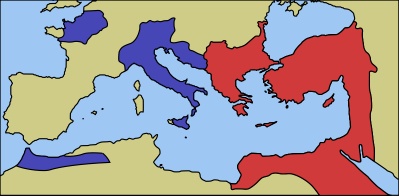 The Eastern Roman Empire (red) covered a vast domain at the time of the dissolution of the Western Roman Empire (purple) in 476 AD
The Eastern Roman Empire (red) covered a vast domain at the time of the dissolution of the Western Roman Empire (purple) in 476 AD
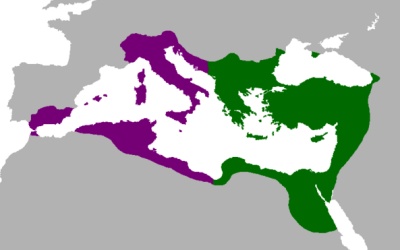 By 600 AD, the Eastern Roman Empire (green) had re-conquered and added to its empire large sections of the old western empire (purple), including Italy and Rome
By 600 AD, the Eastern Roman Empire (green) had re-conquered and added to its empire large sections of the old western empire (purple), including Italy and Rome
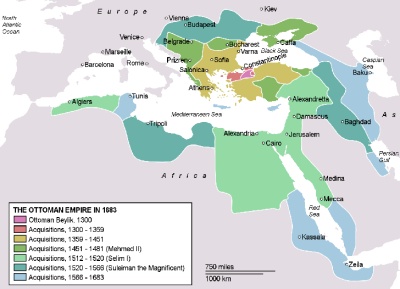
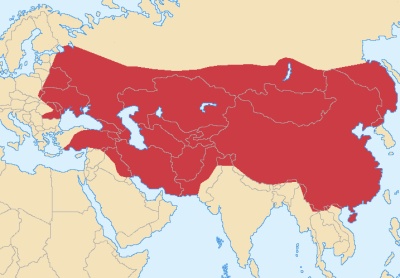 As further evidence of this, there was yet another world empire that dominated the world even before the Ottoman Empire arose. That empire was the Mongol Empire. Founded in 1206 AD, this empire dominated the world for over 150 years, until its demise in 1368. This immense empire was the largest empire ever founded upon the earth. On the right is a picture showing the extent of its dominion. It stretched from the Pacific Ocean on the east to Eastern Europe on the west. It included China, Mongolia, Southern and Western Russia, Persia, Mesopotamia, Pakistan, Kashmir, part of Turkey, and even extended into the Eastern European nations of Poland and Romania. It covered an area more than twice the size of the Roman Empire at its peak.
As further evidence of this, there was yet another world empire that dominated the world even before the Ottoman Empire arose. That empire was the Mongol Empire. Founded in 1206 AD, this empire dominated the world for over 150 years, until its demise in 1368. This immense empire was the largest empire ever founded upon the earth. On the right is a picture showing the extent of its dominion. It stretched from the Pacific Ocean on the east to Eastern Europe on the west. It included China, Mongolia, Southern and Western Russia, Persia, Mesopotamia, Pakistan, Kashmir, part of Turkey, and even extended into the Eastern European nations of Poland and Romania. It covered an area more than twice the size of the Roman Empire at its peak.
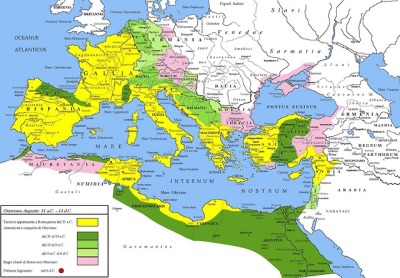 The "Iron" Roman Empire under Augustus with the "Clay" client states shown in pink. Judea was a client state under Herod the Great, who was designated "King of the Jews" by the Roman Senate in 40 BC and gained military control in 37 BC. (Wikipedia)
The "Iron" Roman Empire under Augustus with the "Clay" client states shown in pink. Judea was a client state under Herod the Great, who was designated "King of the Jews" by the Roman Senate in 40 BC and gained military control in 37 BC. (Wikipedia)
